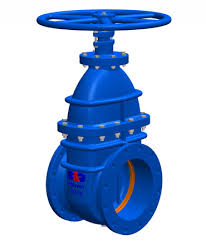Sluice Valve

※ Resilient wedge
※ Size Range: NPS 2 to NPS 24
※ Class Range: PN10/16/150LB
※ Design STD.: DIN 3352
※ Sluice Valve Manufacturer & Supplier
water valve leaking from stem
Specifications
The gate which regulates the sluice is a valve known as the sluice valve. These gates are made to be sealed in one direction and are typically used to regulate water levels and flow in streams and canals. Sluice gate valve can also be used in wastewater treatment plants.
The Application of sluice valve
Cameron is a renowned manufacturer of sluice valves, offering high-quality solutions for a wide range of fluid control applications. Sluice valves are often compared to gate valves, but they differ in their design, functionality, and suitability for specific tasks. Ci sluice valve models from Cameron are particularly well-suited for large-scale water infrastructure projects, where precise flow control and durability are paramount. With a sluice valve diagram showcasing its simple yet effective mechanism, the sluice valve from Cameron provides users with the ability to regulate fluid flow, manage water levels, and isolate pipeline sections as needed, making it an indispensable component in water management systems, flood control, hydroelectric power, and municipal water supply.
How Does a Sluice Valve Work?
The sluice gate valve is controlled by a lifting gate or wedge, allowing water to flow without obstruction. The top end of the stem has a hand-operated wheel or a motor that raises and lowers the doors, while the lower end has a circular or wedge gate to obstruct water flow. This design employs a threaded stem, necessitating several turns to shift from the open to closed position and vice versa, preventing water hammering.
There are two main types of spindles used to raise the gate in a sluice valve:
Raising Spindle type valve: In this design, the spindle/stem is connected to the gate, and the spindle does not rotate with the handwheel but raises with the spindle.
Non-Raising spindle type valve: Here, the spindle is threaded, and the gate is also threaded internally where it is attached to the spindle. The stem does not raise from its place but rotates to raise the gate using threads.
The sluice valve dimensions typically match the size of the main valve, up to a diameter of 300 mm. For larger diameters, the valve size is roughly two-thirds the size of the main valves.
Where Do We Use The Sluice Valve?
Sluice gate valves are commonly used to cut off the liquid flow and cannot be used as a flow regulator. In a completely open position, there is no obstacle in the flow path by the sluice valve, which result in very little flow-resistance. When you move the gate, the size of the open flow path normally varies in a non-linear way. This indicates that the flow rate does not vary with the stem travel uniformly. Depending on the structure, a partially opened gate will vibrate due to the flow of fluid. Sluice valves are often used for larger pipe diameters as they have easy and simple construction than other types of large valves.
At high pressure, friction may become a concern. As the gate is forced against its guide rail by the force of the medium, it becomes more difficult to operate the valve. Large gate valves are often equipped with a bypass that is controlled by a smaller valve so that the pressure can be decreased when the gate valve is operated.
Sluice Valve Installation And Maintenance
Sluice gate valves are very easy to use and are long-lasting when their installation is done in a proper way and the maintenance is carried out in a regular interval.
- Installation of Sluice valve.
- These valves can be fitted in any orientation but if a large valve is to be used then it should be fitted in an upright position for ease in accessibility to operate the sluice valve.
- The material of the valve body, stem, and disk are to be checked before installation.
- It is to be verified that there is no damage to the valve while transportation or storage. Also check the valve for debris, rust, wrapping material, and dirt before installation.
- Make sure flanges in both pipe and valve are matching after this connect and centre the valve. Insert the bolts and tighten them with even pressure so that the sealing of the valve between the pipe is proper.
- Once the installation is finished try to operate the valve several times to make sure it is in a correct position and did not move from its desired place at the time of installation.
- Testing of the sluice valve is to be carried out with a proper procedure provided by the manufacturer to make sure the valve is working properly and can handle working parameters without any problem.
- Maintenance of Sluice valve.
If the valve is not used regularly it is to be operated and maintained once a month to make sure there are no blockages or wear. Before this, make sure the system pressure is relieved and is not pressurised. To remove the gate for inspection, the bonnet and stem are to be removed. After this check, the sluice gate & guide for any damage or wear and refit/replace the parts after the inspection.
Difference Between Gate Valve & Sluice Valve
Sluice valves and gate valves are somewhat different in operation and usage. A gate valve can be a good option for in-line sealing and sludge applications. But when it is needed for managing the flow in a sluice or stream, the sluice gate valve is the best option for your application.
